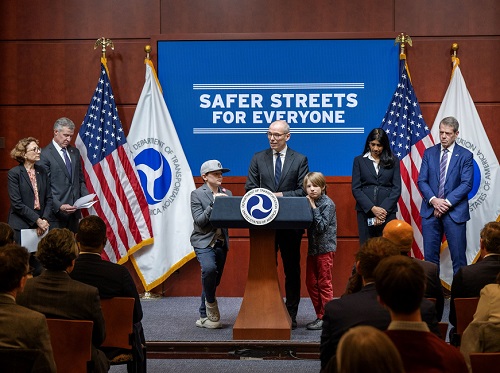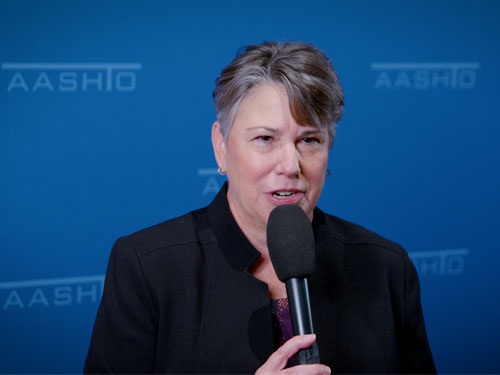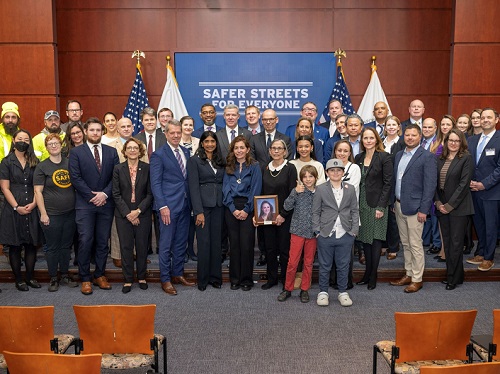The U.S. Department of Transportation held a press event on February 21 at its Washington, D.C., headquarters to highlight the progress made over the last two years on the agency’s National Roadway Safety Strategy or NRSS.
[Above photo via USDOT]
Polly Trottenberg, USDOT deputy secretary, spoke at the press event, which also featured Daniel Langenkamp, founder of the Sarah Debbink Langenkamp Bike Safety Memorial Fund, and sons Oliver and Axel; Jim Tymon, executive director of the American Association of State Highway and Transportation Officials; Maryland Lieutenant Governor Aruna Miller (D); and Nebraska Governor Jim Pillen (R).
The NRSS – launched by USDOT in January 2022 – represents a series of “concrete steps” for the agency to address the “alarming rise” in U.S. roadway fatalities via “systemic changes” to prevent tragic and avoidable deaths and serious injuries on the nation’s highways, roads, and streets.

“There were nearly 43,000 killed on our roadways last year – and these are friends, family members, and fellow Americans,” noted Trottenberg in her remarks. “For 30 years, fatalities on our roadways were on the decline. But over the last decade, progress [on declines] stalled, with fatalities spiking during the [COVID-19] pandemic. While we are now seeing a glimmer of hope, with roadway fatalities leveling off, we know much more work needs to be done.”
Langenkamp talked about the need for better safety measures for vulnerable road users in the wake of the tragic death of his wife Sarah, a U.S. diplomat, after she was struck by a commercial vehicle in August 2022 while riding her bike; pointing out that her death “left a hole in our family” and how tragedies like the one his family has suffered shows how roadway fatalities are not just numbers but represent “a son, daughter, sister, brother, wife, or mother.”
[Editor’s note: Concurrent with this event, USDOT issued more than $1.25 billion in grants via its “Safe Streets and Roads for All” or SS4A program to support local projects that improve roadway safety.]
AASHTO’s Tymon followed Lagenkamp, noting that “sharing such stories” regarding roadway tragedies offers a way to “move the needle” on the critical issue of roadway safety.

“This is not just a national safety issue – it is a national health crisis and we all share a role in driving down roadway fatalities,” Tymon said. “We need to do everything in our power to reduce number of fatalities to zero.”
To that end, he noted that AASHTO hosted a national Safety Summit in 2023 in Kansas City, MO, to bring together state departments of transportation, federal agencies, local governments, and safety advocates to map out ways to improve roadway safety – with another such summit being planned for the fall of 2024.
“These summits are helping us come up with new safety strategies for roads and bridges – to take the different perspectives of all roadway users into account so we do not design roads and bridges in the same way we always have to ensure safety is integrated into everything we do,” Tymon said.
He also noted that AASHTO and its state DOT members subsequently approved a “Safety Resolution” by unanimous vote at the organization’s 2023 Annual Meeting in November 2023 in Indianapolis; a resolution that forms the basis of a “Safety Action Plan” now under development.
“We also believe the partnership we and state DOTs across the country have with USDOT will help us make an impact and eventually drive down roadway fatality numbers down to zero,” Tymon added.
USDOT’s Trottenberg noted that such partnerships – especially where the agency’s “Allies in Action” in support of its NRSS initiative are concerned – are key to enabling USDOT to engage communities across the country in roadway safety improvement efforts.
“It’s going to take a safe system approach to get to zero, based on ideas coming up from the local level, not ‘top down’ from the federal government,” she explained.
“We really want communities large and small, urban, rural, and tribal, to be involved. We want to make sure we are reaching out to them; and you need to help us with that outreach,” Trottenberg said. “There is no silver bullet to this issue; it is part of the NRSS theory that tackling this challenge with incredible partners like yourselves all over the country will get every part of the [transportation] ecosystem working together. We can’t do it without you – we have to get the word out and touch every corner of this country.”
Gov. Pillen echoed that sentiment, noting that “safety is a big deal in Nebraska, in both our workplaces and roads; so, for anything that can be done to improve safety and that makes sense, we embrace it.”
He noted that Nebraska has been “on a great trajectory” in terms of decreasing roadway fatalities and pointed to a host of roadway safety infrastructure initiatives – such as the construction of “R-CUTS” or Restricted Crossing U-turn intersections used primarily on four-lane divided highways, roundabouts, cable median barriers, and the installation of over 6,000 retroreflective stop signs – as critical to achieving that decline.
The Nebraska Department of Transportation has also been active in helping provide local law enforcement and first responders with crash response training as well. In November 2023, roughly 80 first responders from across Nebraska participated in a Traffic Incident Management or TIM live field exercise hosted by the Nebraska DOT and Nebraska State Patrol.
That Traffic Incident Response Exercise or TIMEX, held at the Law Enforcement Training Center in Grand Island, NE, included law enforcement officers, fire and rescue personnel, emergency medical services, transportation agencies, towing and recovery professionals, notification and dispatch personnel, hazardous materials management responders, coroners and medical examiners, and public works professionals from across the state.
Meanwhile, Lt. Gov. Miller added at the USDOT event that the nation’s roadway safety focus must also extends to the crews working to maintain the U.S. roadway system as well. “The men and women who build our infrastructure put themselves in harm’s way every single day,” she said, emphasizing that they need more protection.
In fact, Lt. Gov. Miller – a transportation engineer with 20-plus years of experience – is leading a Maryland work zone safety task force that has recommended ways to better protect roadway workers.
“I’ve seen firsthand the safety challenges associated with highway work zones,” she said during a National Work Zone Awareness Week event in April 2023; an event held not long after six Maryland highway workers were killed in a crash in Baltimore County. “The safety of all highway users, as well as those who improve and maintain our highway network, is paramount.”
That’s why Lt. Gov. Miller stressed at the NRSS event that the work to make U.S. roadways safer will always be an ongoing endeavor. “It is why we are all here,” she said. “The road to progress is always under construction – and, by the same token, the road to safety is always under construction. We must do much more to protect all of our roadway users.”
 Top Stories
Top Stories
USDOT Makes $1.5B Worth of BUILD Grants Available
December 19, 2025 Top Stories
Top Stories

